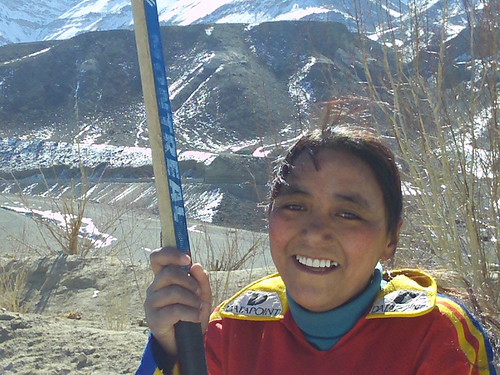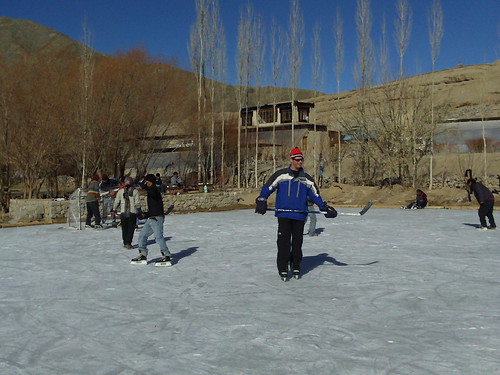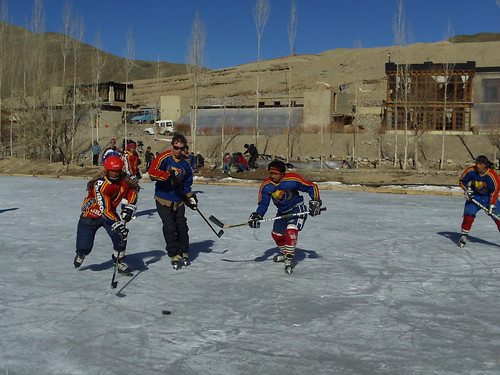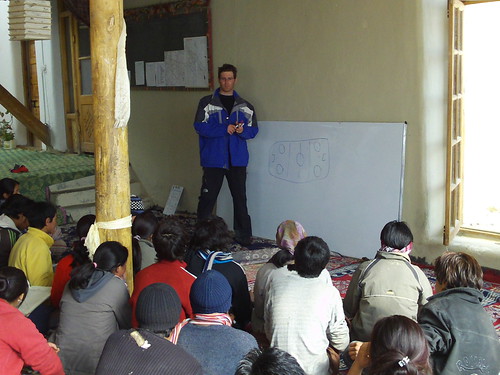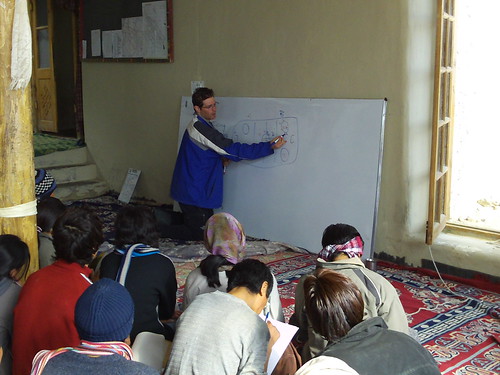You may or may not know, but my original motivation for coming all the way to Ladakh for hockey was to work with the students at SECMOL (Students’ Educational and Cultural Movement of Ladakh). This had come about after a random email sent my way from my friend and former colleague Angela Ruggiero of Team U.S.A. Hockey involved SECMOL, and I decided to research a bit what it was about. The more I read, the more I was compelled to help. SECMOL is a non-profit that has a campus about 20km outside of Leh, in the middle of a mountainous desert, on a cliff overlooking the Indus River. It is in an absolutely gorgeous scene. These days, SECMOL exists to provide children from around Ladakh, mostly those from less fortunate families (in an area that is already very humble compared to life in the West – “Things we take for granted…”), and provides them with a rounded education, teaches them practical responsibilities, and allows more than enough opportunity for fun and constructive interpersonal interaction. Throughout the year, high school students from VIS (Vermont Intercultural Semesters) come to Ladakh and spend some time at SECMOL teaching the students English, working on school-work for credit, and providing the SECMOL students and staff with an opportunity to learn about life and culture in America – in particular, Vermont. The campus is solar powered, and after a handful of ventures into educational services, liberal magazine printing, and childrens’ books, solar paneling is among the few remaining business that allows SECMOL to make revenue independent of donations and the fees collected from students and volunteers. On their website, there was a request for a hockey coach, and like a slap shot to the temple, I was overtaken with a swelling of emotion by the calling that had come out of nowhere, or had it? Around the world, there are handfuls of people that believe in fate, or the edict that “things happen for a reason”, and others in the philosophy of karma – that what we do has a direct impact on what happens to us (simply: cause and effect). For many, The Secret was powerful source of inspiration to really focus on our dreams. Malcolm Gladwell would argue that it’s the situation unto which we were afforded in life, mixed with a fair degree of randomness, hard-work, and luck, that lead to our outcome in life. Others take the “more practical” route that we make our own opportunities, and that randomness has nothing over good ‘ol sweat, blood and tears. For some time now, many of these philosophies have resonated for me, some of them conflicting or harmonizing with each other, and when my tenure with the Islanders ended, I knew that the time to test my character and put my dreams into motion had arrived. All of my life’s experiences to that point had provided me with a foundation to grow upon, and when this email came my way from Angela, I had already identified many of the things important to me to live a happy life: traveling, playing hockey, drinking tea, doing good for others/generating good karma, meeting interesting people, forming lasting connections/friendships, never working a “9-to-5” again, being my own boss, finding a path to enlightenment (seriously). These are things I consider passions that define me, some are simple, some are complex, but all are important. With the pursuit of passion, there is still a business plan, and a desire to make money, but never the motivation to put money before happiness. The opportunity to travel to Ladakh, a Buddhist (Buddhism is based upon compassion, doing good for others, and the pursuit of enlightenment) region in the Himalayas of India, one of the world’s most unique countries, where ice forms naturally and hockey is played with passion, where I could drink endless amounts of tea, and do things the way I feel are important in life and in business was too much to resist. This email regarding SECMOL opened my eyes and provided me with the path to follow through on my pursuit of happiness, and so became “The Hockey Volunteer” initiative. In my first day of emails with SECMOL, on December 8, 2008, I had enquired into how much my trip would cost, and promised that I would make it to Ladakh the moment I had raised the appropriate funds. The cost to make it to India and survive for 1 month on meager conditions was $2000. The cost to stay longer and still live pretty modest, $3000. If I was to bring hockey equipment, $4000. My goal was to raise the money before the ball dropped and 2008 had ended, and I set out on utilizing the digital world as my primary resource for fundraising. Being a card-holding member of Generation Y, and someone that has always been keen on utilizing computers and new technology, this was something I had a passion for, and had experience with when I could say “I’m Adam Sherlip, and I’m an ‘Islander’”. Unknown to everyone, up until now, is that I vowed to myself that I would plaster the internet with this program for the sheer point of proving that it could be done, and that technology could be used to make a difference in peoples’ lives if we truly allow it. I was never given the opportunity to utilize new media/digital marketing the way I wanted previously, and this was my opportunity to prove my old bosses wrong. I wouldn’t call it vengeance, or anything of similar harshness, but rather the opportunity to prove to myself and to those that had doubted my expertise and/or idealism that both could succeed, simultaneously. Now at this point, you may be thinking this is about ego, and I want to vow to you that my only boost in ego is when I see the difference I have made in the lives of countless people to date, using hockey as my tool. That’s it. I feel good, when I’ve done good*. The rest is fluff. Yes, it’s important to have motivation. Yes, it’s important to have dreams and goals. But none of that compares to knowing that your services are not only needed, but they are requested and appreciated. On January 12, 2009, just over 1 month from deciding the path my life would take herein, I departed for Ladakh, by way of Frankfurt, Germany and Delhi, India. I differentiate between Delhi, India and Ladakh because this is truly a world unto itself. During the Winter, Ladakh is cut off from the rest of the world, including it’s neighboring regions: Zanskar, Jammu and Kashmir (the name of the state). With me on this initial voyage was a bundle of 14 hockey sticks, 2 pairs of skates, some pucks, my gloves, and 2 sets of netting. I was told that lefty sticks were called “righty” and righty sticks were called “lefty”, and that what I know as lefty sticks was in high demand. As a result, I brought a half-dozen of my old lefty sticks, and received donations of another half-dozen sticks from a local Play it Again Sports on Long Island, of which only 3 were righty, and two of those were for children. Originally, my plan was to receive a donation or purchase two sets of hockey goals that came with large backstop-netting, so that wide shots would stay in the rink. In the meantime, I had discussed with SECMOL the proper size of the nets, and when they notified me they had welded some pipe to regulation size, I was able to purchase netting to line the pipes. The morning of my departure, I rushed out to a sporting goods store the moment they opened, and purchased lacrosse-style netting, against the recommendation of the people in the store. I then went into the neighboring hardware store and purchased 1 large bag of industrial strength ties. Both pairs of skates were mine from the past, and along with the rest of my equipment, the plan was to leave everything behind. It’s very Buddhist not to hold on to possessions, and since everything is replaceable for me, and difficult to get for the Ladakhis, it seemed like the best option. That, and I would be able to lighten my load for when I began my travel around India. As you know from my first post here in Ladakh, my child-like tendencies took over and I had jumped onto the rink within a couple of hours of arriving, stupidly taunting the altitude to prove that it could debilitate me. Prior to the headache that REALLY felt like a slap-shot to the temple, I was told that the sticks I called lefty are also called lefty in Ladakh (shocker, I know), and that they had actually needed righty sticks, as over 90% of the players shoot from the right side. Damn. In that first session on the ice, the mid-level players, many female, were on the ice playing around with one of the instructors from Vermont. She quickly deferred to me, and I showed everyone how to take a proper wrist shot (naturally, I missed the net on one of my first attempts, but no matter), and then worked on some puck-handling drills before getting into a scrimmage. This was my only lesson for the better part of two weeks. The oldest boys’ team was participating in a local tournament, the same tournament I identified as having a SECMOL player dominating his competition on selfish play, and while they were competing in the late rounds of the tournament, the rest of us traveled to the opposite side of Ladakh to participate in a tournament in Chiktan/Kargil, co-sponsored by SECMOL. At this point, I was made aware that there was more tournament play upcoming when we returned to the Leh area (the capital of Ladakh), and that many of the top players would be involved in that tournament too. We agreed that my instruction should begin after the tournament ended. The only other interaction with hockey at SECMOL was in the scrimmage we organized between our American team and the top boys’ team, in which we absolutely demolished our better conditioned/acclimated opponents on the backs of our superior passing (and speed and shot accuracy). As we played out our drubbing, I made a point to call out the selfish play of the “all-star”, and noticed his game (along with the rest of his teammates) morphing into a cone-like strategy of stand and wait for the puck to come. Again, based on earlier posts, you know that the tournament I speak of was the national tournament, and I had become heavily involved in everything around this event, including the drama, unfortunately. In the middle of the national tournament, was the Canadian tournament, and when all was said and done, 7-8 days were devoted to these two conjoined hockey happenings. During this period, I was practically unseen at SECMOL, waking up early to head into Leh, staying in town all day, and returning late at night, if I returned at all. Although we had discussed that my lessons would begin when all of this ended, I was starting to feel like a man who wasn’t living up to his word. I had come to Leh for SECMOL, and was seen dealing with an organization that has had strained relations with the embattled NGO: the Ladakh Winter Sports Club. I had to be repeatedly reminded by my friend Henk that I was in Ladakh for hockey, and based on my discussions with SECMOL and my contribution to the rest of Ladakhi hockey, I was upholding my initial goal: to share happiness one puck at a time. Phew, I was getting worried. As the tournament was winding down, I organized an off-ice hockey class at SECMOL to go over the basics of hockey. Just like with the local referees, this class was focused on discussing penalties, off-sides, and icing. The group was engaged for an hour, working through my English, a translator, and “Slap Shot”-like demonstrations of how to commit the penalties, as well as the signals for them. At the same time, I began working with the most advanced players from SECMOL in private sessions (which ended up quickly becoming public, because many of the other students would force their way in), including the player previously identified as selfish. He had performed relatively miserably in his earliest matches in the national tournament, and I attempted to reinforce what constitutes quality hockey in North America. Our time together wasn’t as productive as I would have liked, as he had a hard time understanding the concept of a snap-shot (something I didn’t want to get into, but one of the Vermont students had introduced it), as well as how to break out of the defensive zone and find the puck. People used to say that Wayne Gretzky would always “have the puck find his stick”, but in reality that means that Gretzky was smart enough to understand where the puck was going, and make sure he was there. These were the things I was trying to teach him, as well as how to make close passes while moving in all directions. The conditions of the ice at this point in the training was less than forgiving, and at one point I caught my skate in a deep rut, and fell backwards on my lower back, an area I severely injured in a hockey when I was a teenager, that gets easily aggravated and affects all movement in my body when it flares up. Fortunately, this pain subsided quickly, and without any intense spasms. When the tournament ended, I was able to really get to work with the SECMOL players. In the late afternoons, as the sun was setting, I dragged “formerly selfish” out onto the ice, along with a few of his teammates, and we worked on honing some of the intermediate skills, like deflections and breakouts. In the mornings (yes, I’m going backwards), I spent a couple of days instructing the less advanced groups, working on passing, skating (in particular, backwards), shooting, and 2-on-1 drills. In the evening, we went back into the classroom for a few more lessons. You already know day one. Day two discussed face-off positioning, and day three was about zone-play, including break-outs. Afterwards, I gave the group an overview of the NHL, including listing all of the teams and showing where they were on the map. To my disappointment, these so-called hockey fanatics knew nothing about the NHL, or about North American geography. To my further disappointment, I forgot one NHL team, and not until 4 days later did I remember which team I had left off out of the hockey geography lesson: sorry Colorado Avalanche fans! All of this training with the players at SECMOL was in my final scheduled days in Ladakh, but as you will soon find out, this intense period of hockey overload and instruction at SECMOL was only a sliver of what was going on. It only gets better! *I have made a conscious decision to ignore the foundations of proper grammar here, and use “good” instead of “well”. I think the term “I’ve done good” is much more representative of something that feels inherently decent and morally right, whereas “I’ve done well” seems mediocre and impersonal.


